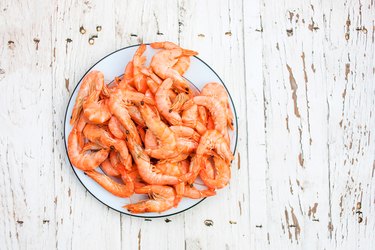
Farmers around the world grow freshwater prawns to increase their income. These crustaceans offer consumers many benefits <ahref="https: www.livestrong.com="" article="" 527990-nutrition-facts-for-prawns="" "=""> </ahref="https:>as well. Yet prawns aren't perfect. Eating them may elevate your cholesterol levels, and prawns may be contaminated by environmental pollutants.
Read more: Are Prawns Good for Weight Loss?
Video of the Day
Video of the Day
Abundant Nutrients
Prawns have a healthy macronutrient profile. They're high in protein, low in carbohydrates and contain very little fat. For example, a 3-ounce serving has about 17 grams of protein and less than 1 gram of both carbohydrates and fat. Including prawns in your diet provides the types of nutrients you need to promote muscle and reduce fat.
Essential Minerals
Freshwater crustaceans are also rich in minerals. A 2017 report in Fishery Technology showed that prawns contain an abundance of magnesium, potassium, phosphorus, calcium and copper. The authors of the report noted that crustaceans caught during different seasons had different mineral profiles for the most part. The mineral that remained constant throughout the year was calcium.
Read more: Lists of Foods High in Minerals
Essential Vitamins
Prawns deliver many healthy vitamins as well. For example, they're a great source of vitamins A, D and E as well as vitamins B1, B2 and B3. Interestingly, irradiating crustaceans to remove bacteria increases their vitamin A and E content.
Read more: List of Vitamins and Their Uses
Fatty Acids
Prawns also offer an excellent source of polyunsaturated fatty acids. These fats include the omega-3 fatty acids known to lower your heart attack risk. Authors of an article published in the International Journal of Fisheries and Aquatic Studies recommended prawns as a healthy food choice due to their omega-3 fatty acid content.
Read more: Omega-3 Supplement Side Effects
The Cholesterol in Prawns
Prawns offer a number of health benefits but also contain a high amount of cholesterol, nearly 200 milligrams in a 3-ounce serving. Some experts recommend limiting the intake of foods, like prawns, that are high cholesterol. But a 2015 thesis from Liverpool John Moores University tested this recommendation in healthy men, with the results indicating no adverse effects from eating prawns.
If you have a history of high cholesterol or heart disease, though, play it safe by consulting with your doctor about how foods like prawns might fit into your heart-healthy diet.
Read more: How Bad Is the Cholesterol in Shrimp?
Prawn Toxicity
Scientists often use prawns as a biomarker for environmental damage. For example, construction pollution lowers prawn numbers. Because consumers can absorb these toxins by eating contaminated crustaceans, it's a good idea to seek a safe source of edible prawns.
A 2015 article in Food Chemistry highlighted the lower levels of heavy metals evident in farm-raised prawns. The authors of the study demonstrated that wild-caught prawns had high levels of cadmium and arsenic, which should be avoided as they're considered possible causes of cancer.
Read more: Side Effects of Cadmium
Prawn Genetics
Environmental toxins cause genetic changes in prawn offspring. Manufacturers also intentionally breed larger prawns, according to a 2018 report in Reproduction in Domestic Animals. But, if you enjoy eating prawns, it's a good idea to keep in mind that biotechnology has advantages and disadvantages and that the effects of eating genetically altered prawns remain unknown.
Read more: Fishing for Answers
- World Aquaculture: Polyculture with Carp, Nutrient-Rich Small Fish and Prawn
- Journal of Child Science: Nutrition for Hypercholesterolemic Children
- Food Chemistry: Stable Isotope and Trace Metal Compositions of Australian Prawns as a Guide to Authenticity and Wholesomeness
- International Food Research Journal: Proximate Composition and Energetic Value of Selected Marine Fish and Shellfish From the West Coast of Peninsular Malaysia
- Nutrition, Metabolism, and Cardiovascular Diseases: Long-Term Weight Maintenance After Advice to Consume Low-Carbohydrate, Higher-Protein Diets
- Fishery Technology: Review on Biochemical Composition and Microflora of Prawns
- Biochemistry: Irradiation of Red Sea Shrimp Increased Its Content of Vitamins A and E
- International Journal of Fisheries and Aquatic Studies: Evaluation of Nutritional Status of Penaeid Prawns Through Proximate Composition Studies
- Liverpool John Moores University: The Role of n-3 Fatty Acids in Cardiometabolic Risk
- Ecotoxicology and Genotoxicology: Freshwater Prawns Macrobrachium borellii and Palaemonetes argentinus (Crustacea: Palaemonidae) as Valid Indicators of Organophosphate Pesticide Exposure
- Texas A&M University: Dominica Study Abroad Trip: Prawn Population Diversity in the Check Hall River
- Healthfully.com: 5 Things You Need to Know About Arsenic Poisoning Symptoms
- Marine Pollution Bulletin: Genetic Diversity of the Giant Tiger Prawn Penaeus Monodon in Relation to Trace Metal Pollution at the Tanzanian Coast
- Reproduction in Domestic Animals: Quantitative Genetic Changes in Reproductive Performance of Giant Freshwater Prawn After 10 Years of Selection for Increased Growth Rate
- Nutrionix: Prawns